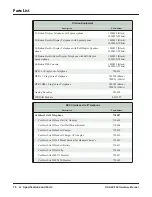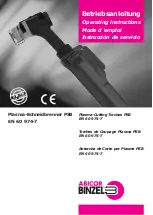
P.28
morning, the check valve (COMPONENT #4,
FIGURES 15A; 15B; 16A; 16B; 17A; 17B
) may not be seating correctly and should be
cleaned or replaced. Also make sure that the
circulating pump is not running at night. If
the pump is running and the controller displays
questionable temperatures at the collector or
tank (i.e. 180°F tank and 45°F collector), check
both sensors using a resistance meter to see
if they are correctly calibrated. If you find a
defective sensor replace it immediately.
Note that in a two tank system night time heat
loss will be harder to detect, especially if you
are operating in the solar preheat mode. Check
the line thermometers (if installed) in the collec-
tor loop piping to detect night thermosiphoning.
9.10 If the weather is poor and the auxiliary
heating element will not fire, the bright red
reset button on the thermostat may have to be
depressed to be reset. Single tank systems have
one heating element and thermostat. Double
tank systems with conventional electric water
heaters have two heating elements and thermo-
stats (COMPONENT #29, FIGURE 16).
DANGER: NEVER REMOVE THE
PROTECTIVE ACCESS PLATE ON THE
EXTERIOR OF THE SOLAR STORAGE
TANK OR CONVENTIONAL WATER
HEATER WITHOUT DISCONNECTING
THE 230 VAC POWER SUPPLY AT THE
CIRCUIT BREAKER.
After the circuit breaker has been turned off,
remove the access plate on the storage tank or
water heater and depress the red reset button
on the thermostat. If it clicks when depressed
the heating element should fire immediately
when you reconnect the circuit breaker. It the
reset button does not click and you do not have
hot water after one hour, the heating element
or thermostat may be defective. Contact your
installation contractor for service.
In two tank systems the conventional electric
water heater will be wired for electrical back-
up. The solar tank will serve solely as a storage
tank and will not be wired.
10) SYSTEM COMPONENT PARTS
See Figures 15a; 15b; 16a; 16b; 17a and 17b for
the location of the specific components num-
bered below.
1. SunEarth Solar Collector(s): Absorbs the
sun’s heat energy and transfers this heat to the
HTF circulating through the collector.
2. Collector Sensor (T1): Wired to the system
controller. Works in conjunction with the tank
sensor to automatically turn your circulating
pump on and off at preset temperature differ-
entials.
3. Optional Tank and Line Thermometers:
Used to determine proper system operation.
Line thermometers will show an approximate
5°F - 12°F temperature difference between the
collector supply and return lines on sunny days.
In a single tank system the tank thermometer
will read the temperature of the water after the
mixing valve feeding your fixtures. In two tank
22
24
25
26
22
24
25
26
Solar Preheat Fig 19a
100% Utility Power Fig 19b
fig. 19b
SOLAR 100%
UTILITY POWER
















































